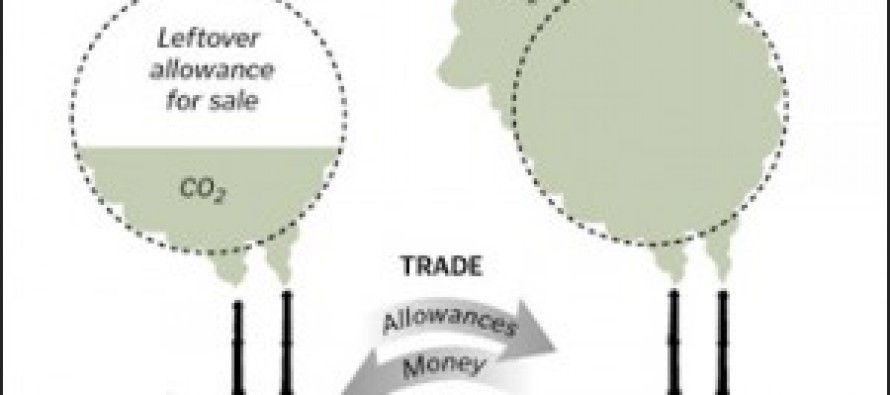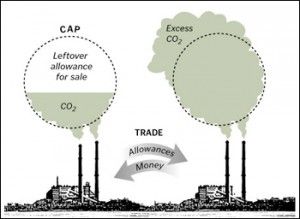‘Climate credit’ begins march through CA

 Beginning this month, millions of Californians will see something new on their electricity bills: a “climate credit.”
Beginning this month, millions of Californians will see something new on their electricity bills: a “climate credit.”
The line-item credit will range between $30 and $40. It will function as most Californians’ first direct experience with AB32, the Global Warming Solutions Act of 2006. AB32 mandated that carbon emissions be reduced by to 1990 levels by 2020.
To implement AB32, the California Air Resources Board imposed a cap-and-trade system of emissions credits. The system affected roughly 350 businesses deemed responsible for 85 percent of emissions. It required them to cut emissions output below forecast levels. In 2013, that meant affected businesses cut emissions by 2 percent of the 2012 forecast. This year brings another 2 percent cut.
But from 2015 to 2020, annual cuts must be 3 percent of the prior year’s level. According to CARB, the combined cuts will bring “an overall 15 percent reduction in greenhouse gas emissions compared to the ‘business-as-usual’ scenario in 2020 if we did nothing at all.”
Critics question if AB32’s economic damage is worth the relatively modest cuts. The cuts pale next to emissions levels around the world.
Supporters counter that the law is designed to link up with similar pieces of state-level legislation, such as SB375. That’s a 2008 bill by state Senate President Pro Tem Darrell Steinberg. According to the Institute for Local Government, “SB375 builds on the existing framework of regional planning to tie together the regional allocation of housing needs and regional transportation planning in an effort to reduce greenhouse gas (GHG) emissions from motor vehicle trips.”
Then-Gov. Arnold Schwarzenegger signed into law both AB32 and SB375. Critics charged that the bills reduced California’s productivity, especially in manufacturing.
Just before cap and trade went into effect in fall 2012, the California Manufacturers and Technology Association released a report charging the new program would hurt manufacturing.
Opposition
As cap-and-trade implementation shifts into higher gear, politicking around the law is ratcheting up. Despite broad support for legislation that treats global warming – now usually called “climate change” — as an established scientific fact, some public opposition to rising energy costs is inevitable.
The cap-and-trade system is designed, in part, to blunt such concerns. But advocates’ focus on the immediate benefit of the credits risks amplifying criticism by downplaying the credits’ broader purpose.
Writing in the San Francisco Chronicle, two environmentalist legal activists, Ryan Young and Alex Jackson, defended cap and trade. They wrote customers faced an “unprecedented opportunity” to “slash their energy bills even further” by “investing the amount of the credit, or even part of it, in a low-cost energy efficiency option that will pay off in lower bills for years to come.”
Yet electricity rates already are rising for some customers. The Energy Upgrade California website tallied the new costs imposed on the state’s power plants. It found the costs “are reflected in all customers’ electricity generation rates”; and in “the portion of electricity bills that represents the costs to generate electricity.”
‘Sticker shock’
In sum, the purpose of the climate credit system is twofold:
1. Create the impression electricity isn’t costing more;
2. Use that comfort level to push consumers into spending their “credits” on alternative energy, LED light bulbs, etc.
Young and Jackson explained that, eventually, the money does wind back to consumers. But only if the consumers spend their climate credits how they’re told. They wrote, “You’ll easily cut your electric bills enough over time to cover the initial cost, essentially doubling your climate dividend.”
But savings, if they come, may not last. A PG&E Spokesman Jonathan Marshall warned, “The revenue returned to customers is greater than the costs that will be put into rates. Nevertheless, there are substantial costs that are part of the whole greenhouse gas program.”
So customers are poised to reap up-front “climate credits” on their electricity bills. But the rebates alone might not make up for the added costs.
Related Articles
Janet Napolitano rebukes policing speech on college campuses
With a single op-ed, UC chief Janet Napolitano has become an unlikely ally of conservative and traditionalist critics of the
Plethora of Initiatives Headed Toward 2016 Ballot
According to the recent Public Policy Institute of California poll, state residents like the initiative process but think too
Why would Sacto tap a failed leader?
Commentary JULY 22, 2011 By STEVEN GREENHUT The Sacramento Bee reported today that John Shirey, executive director of the California




